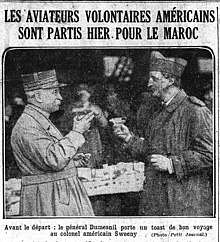Bombardment of Chefchaouen
The Bombardment of Chefchaouen was an aerial bombardment of Chefchaouen, Morocco carried out in the middle of the Rif War by a rogue American squadron in the service of the French colonial empire on September 17, 1925.[1]

Colonel Charles Michael Sweeney, an American pilot who had served in World War I,[2] proposed organizing a squadron of American pilots to assist the French in Morocco, to French Prime Minister Paul Painlevé, who "warmly welcomed the Colonel’s request."[3]
Association_des_bpt6k96881165_26_(1).jpg)
Seeking "volunteers," Sweeny sent a telegram to a number of WWI veterans in the US in June 1925. By July, he had 17 volunteers, 12 of whom were pilots, including Paul Ayres Rockwell, had served France in World War I.[1][4] The American volunteers were inducted into the French Foreign Legion in July, and their squadron was named Escadrille Cherifienne, 19th Squadron of the Moroccan Aviation Regiment.[5]
In a telegram to the French résident général in Morocco Hubert Lyautey, the Prime Minister and Minister of War of France Paul Painlevé said: "This American expression of solidarity seems particularly interesting at the moment and capable of bringing a share of American propaganda to our cause, strengthening American sentiment against the aggression of Abd el-Krim."[5]
In Morocco, the American volunteers of the Escadrille Cherifienne were based in Beni Malek.[6]
Squadron
- Colonel Charles Michael Sweeny[7][8]
- Captain Paul Ayres Rockwell[7]
- Commander James Sussan/Susson, *Canadian, former commander pilot in the Royal Airforce of England[7][8]
- Donald Mac Gibeny, former pilot of US Air Force[7]
- Captain Samuel J. Mustain, former pilot of US Air Force[7][9]
- Doctor James V Sparks, who enlisted as a medic[7][8]
- Captain George Butts[7][8]
- George Rehm[7]
- Lieutenant Charles W. Kerwood[8][7]
- Commander Grandville Pollock[8][7]
- Lieutenant-Colonel Austin G. Parker[8][7]
- Captain Reginald H. Weller[8][7]
- Captain Graham[7]
- Captain Lansing C. Holden[7]
- Captain William G. Bullin[7]
- Lieutenant William S. Cousins[8]
Official US position
The US Department of State instructed its consul at the American Legation in Tangier, Maxwell Blake, to warn the Americans that they would risk the revocation of their US citizenship, imprisonment, and fines if they battled "against a people with whom the United States had no quarrel."[10]
Motivation
On the motivation of the rogue American volunteer pilots, Sweeney wrote, "In our view, France, in fighting Abdel Krim, is fighting the cause of the white man's civilization, and all who have formed this squadron know enough of the world to appreciate what the white man's civilization means."[11]
The motivation to bomb Chefchaouen specifically was to drive the Jebala people out of the war, as it was a city the tribe considered holy.[12]
Reflections
_bpt6k46037774_4.jpg)
Paul Ayres Rockwell later wrote: "The city looked lovely from the air, hugging its high mountain and surrounded with many gardens and green cultivations… I looked down upon the numerous sanctuaries, the six mosques, the medieval dungeon, the big square with its fountain playing and fervently hoped none of them had been damaged."[12]
References
- Yabiladi.com. "History : When an American squadron violated US neutrality laws, bombing Chefchaouen". en.yabiladi.com. Retrieved 2019-07-14.
- "Why Americans Volunteered to Bomb a Moroccan Mountain Town in 1925". Code and Dagger. Retrieved 2019-07-14.
- Roberts, Charley, 1948- author. Charles Sweeny, the man who inspired Hemingway. ISBN 1476669945. OCLC 1011663811.CS1 maint: multiple names: authors list (link)
- Roberts, Charley; Hess, Charles P. (2017-09-08). Charles Sweeny, the Man Who Inspired Hemingway. McFarland. ISBN 9781476669946.
- Roberts, Charley; Hess, Charles P. (2017-09-08). Charles Sweeny, the Man Who Inspired Hemingway. McFarland. p. 153. ISBN 9781476669946.
- "Excelsior : journal illustré quotidien : informations, littérature, sciences, arts, sports, théâtre, élégances". Gallica. 1925-10-03. Retrieved 2019-07-15.
- texte, Parti social français Auteur du (1925-08-06). "Le Petit journal". Gallica. Retrieved 2019-07-19.
- texte, Association des dames françaises Auteur du (January 1926). "Bulletin de l'Association des dames françaises / Croix-rouge française". Gallica. Retrieved 2019-07-19.
- Baltimore Sun, U.S. Flyers in Riff Termed Civilian Slayers in Report, 17 Oct 1925, p. 1, 10
- Roberts, Charley; Hess, Charles P. (2017-09-08). Charles Sweeny, the Man Who Inspired Hemingway. McFarland. ISBN 9781476669946.
- Deacon, Richard (1972). One Man's Wars: The Story of Charles Sweeny, Soldier of Fortune. Barker. ISBN 9780213994327.
- Roberts, Charley; Hess, Charles P. (2017-09-08). Charles Sweeny, the Man Who Inspired Hemingway. McFarland. p. 154. ISBN 9781476669946.